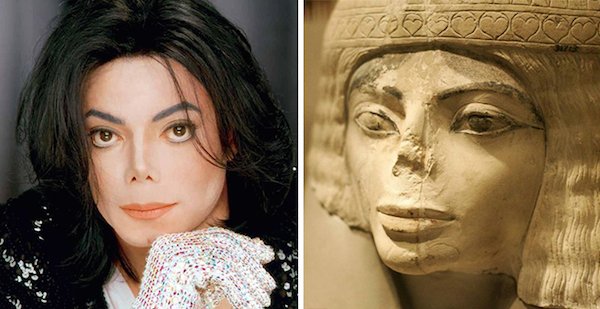When the King of Pop Michael Jackson passed away in 2009, fans started trooping into a museum in Chicago to see an ancient Egyptian bust that looks like the singer. The limestone figure, which depicts an unidentified woman, stood in the corner of the Field Museum of Natural History in Chicago for many years, about two decades before Jackson died.

However, it rarely got that much attention until after a newspaper article highlighted Jackson’s similarities to the bust. “We’ve had people coming to the museum and asking ‘Where’s Michael Jackson?’ So we have to tell them that he’s not here, but there is a bust that looks a lot like him,” Museum curator Jim Phillips told AFP in August 2009.
“People are coming from all over the country to see the statue and compare its likeness to the king of pop,” the museum’s director of guest relations, Darnell Williams, added in another interview.
The 3,000-year-old Egyptian artifact, which has rounded eyes, bony cheeks, and a nose almost like that of the late music icon, was purchased and brought from Cairo at the end of the 19th century. It went on display at the Chicago museum in 1988, and though its exact origins remain unknown, historians agree that it was carved during the New Kingdom Period, dating from between 1550 BC to 1050 BC.
Some say that this could mean that the bust was created when Egypt was under the boy king Tutankhamun, or when Ramesses II was king.
The bust, which was named the Pharaoh of Pop by the media, has continued to attract many to the Chicago museum who have said that it reminds them so much of the late Jackson, particularly its “partially disintegrated” nose. Just like the woman’s bust, many Egyptian sculptures, including sculptures from other areas such as Rome, have had their nose or other parts missing or damaged.

There were religious reasons. According to Vintage News, early worshipers of various religions, including Christianity and Islam, defaced statues “so they would make them less profane.” There were other reasons. Many sculptures were unearthed from under tons of sands or mud and they were discovered with their noses, arms or other parts of their bodies missing. Then there were some archaeologists in the past who likely damaged some of these ancient pieces while handling them. Perhaps it wasn’t their fault, as they lacked the necessary tools to work with at a time when archaeology was now developing as a discipline.
It is not known what really happened to the nose of the Jackson look-alike bust. And while the Chicago museum officials have said that they doubt that the late singer’s physical appearance may have been inspired by the statue as he was not believed to have visited the museum, they cannot deny the striking similarities between the two.
Visitors are not allowed to touch the bust, Vintage News reported in 2018, adding that the artifact, measuring almost 10 inches in height and some 13.7 inches in width, remains protected behind a glass screen.
Jackson, who captivated audiences in a career that spanned over four decades, remains a towering influence on artistes today. The singer lived a very private life during his final years. He suffered a cardiac arrest after overdosing on medication to help him sleep in his rented mansion at Holmby Hills in Los Angeles.





